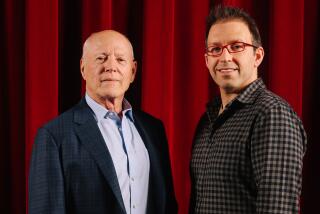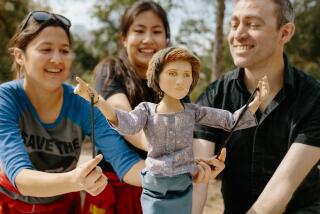Handspring Puppet Company gallops into spotlight with ‘War Horse’
- Share via
Muscles taut, ears alert, Joey the cavalry horse is poised to charge the enemy line. On command, he gallops toward the German guns, heading straight for a swath of barbed wire. At the last moment, he leaps — and disappears in a giant flash of light.
So ends Act 1 during a recent rehearsal for the drama”War Horse,”which opened its first U.S. tour at the Ahmanson Theatre this weekend. While the creative team compares notes, Joey stands and waits, still carrying his rider. After a few minutes, he stomps a hoof as if to say, “Let’s get moving.”
His antics draw laughter and knowing nods. Joey, you see, is the star creation of Handspring Puppet Company — not a real horse but such a faithful rendition of one that he stays in character even between scenes.
Handspring’s life-sized, life-like creatures — shy foal to stallion — have been matinee idols since “War Horse” debuted at the National Theatre in London in 2007. The play, adapted by Nick Stafford from Michael Morpurgo’s 1982 young adult novel, depicts Joey’s journey through the battlefields of World War I and the harrowing efforts of Albert, an English farm boy, to bring him home.
The sentimental saga — told by more than 30 performers and two dozen puppets — has become a theatrical event, its stagecraft pleasing critics, packing seats and propelling Handspring co-founders Adrian Kohler and Basil Jones into the international spotlight.
“Theater is all about the imagination,” says Kohler, the South African company’s artistic director, during a rehearsal break. Artists and audiences bring “War Horse’s” horses to life by joining in a game of make-believe, the illusions even more exciting, he says, because “they happen right before your eyes.”
Handspring conjures these illusions with a blend of subtlety and spectacle. Joey’s body — intricately constructed from cane, plywood, metal and nylon mesh — is borne and manipulated by a trio of puppeteers trained to behave like a horse in ways that, says Jones, “must be slightly unpredictable like a real animal onstage” and yet disciplined enough “to use micro-movements — an ear or tail twitch — to reveal a puppet’s thoughts and feelings.”
When describing their work, Kohler and Jones, in Los Angeles to launch the national tour, often finish each other’s sentences with an ease that comes from having spent most of their lives together. The men, both 60, have been a couple for four decades (a married one since 2007) and have run Handspring for three.
“We are different, kind of yin and yang, but we respect the differences,” says Jones, Handspring’s executive producer. “And we have strengths that are complementary.”
“Adrian,” he says, “is “the designer … the heart and soul of the company.”
“Basil,” says Kohler, “is a visionary.... He is ambitious, and he doesn’t allow doubt to stop the possibility of a project going ahead.”
They enjoy performing. (“War Horse” is their first show in which they aren’t working as puppeteers.) “We also have shared many adventures,” says Jones.
Those adventures began in the early ‘70s, when the pair met in art school in Cape Town. Kohler loved puppets. Jones didn’t.
“Adrian had grown up making them,” says Jones. “I felt they were somewhat beneath me.” He changed his mind a few years later, while living in Botswana, when he discovered the storied puppetry tradition of Mali. “I realized there was a powerful medium to be explored.”
Jones and Kohler started Handspring in Cape Town with two friends in 1981. (The friends eventually left for personal reasons.) They spent the troupe’s early years on the road, performing children’s pieces. In the mid-’80s, they staged their first puppet play for adults, their version of David Lytton’s “Episodes of an Easter Rising,” in which a wounded black activist seeks refuge on the farm of two white women.
“Quite tangentially,” says Jones, “you become aware the women are lovers. So sexual and other forms of politics mix in a way that appealed to us.”
“Episodes”proved to be a surprise success, gaining Handspring exposure that had eluded it as a children’s puppet theater. “It changed the course of the company,” says Kohler. He and Jones moved to Johannesburg and pursued new kinds of projects, including multimedia collaborations with artist William Kentridge.
Handspring has since returned to Cape Town, where, says Jones, “we’ve mainly focused on animals.”
The invitation to join “War Horse” came from Tom Morris, then a National Theatre associate director and a fan of their work. (Morris and Marianne Elliott co-directed the productions in London and New York; Bijan Sheibani is directing the U.S. tour, which runs in L.A. through July 29.)
Kohler and Jones say they tried to create “believable horses that could carry the emotional weight of the show.” They also overcame practical challenges such as building a puppet that could run realistically while being ridden by a man. Before starting his designs, Kohler studied equine anatomy. Handspring and cast members also researched horse behavior (and how people should behave around horses), visited stables and consulted with trainer Monty Roberts.
Joey and his friend Topthorn are operated by a “Head” puppeteer, who works outside the frame, and “Heart” and “Hind,” who work within. Kohler and Jones say puppeteers must be physically adept and resilient (“there’s a degree of pain involved”) and “able to suppress their actor’s egos and be part of a team.” Their intense training-performance regimen reflects Handspring’s belief in focusing on little things in pursuit of a bigger vision.
Even the act of breathing carries special meaning. “An actor struggles to represent death because the audience knows he didn’t really die,” Kohler says. “The puppet is an object that has to strive to live, so we want to show each breath.”
Nicholas Hytner, director of the National Theatre, says he was “bowled over” by the way Kohler and Jones “transform detail into something much more like soul or spirit. They can become obsessive about a particular muscle they want to represent in a particular way. This feeds into a genuinely spiritual sense of what happens when you ask a puppet to interpret the life of a living creature. Something really mysterious happens that I don’t fully understand. It’s hard to describe how music works, and it’s hard to describe how puppetry at this level works.”
As its fifth anniversary nears, “War Horse” is going strong. Besides the U.S. tour, the show is playing in the West End, Toronto and on Broadway, where it won five Tonys and Handspring received a Tony honor for excellence. Other productions are planned.
Handspring’s puppet-making operation has expanded to meet demand. The company now has a British offshoot and a nonprofit, plus, says Jones, “we are inviting young theater-makers to join us.” The puppeteers for the national tour were cast in New York.
In 2010, Jones and Kohler returned to the National to collaborate with writer-director Neil Bartlett on “Or You Could Kiss Me,” an intimate look at two men growing old together. They portrayed the men in middle age, while puppets depicted them in their youth and 80s.
“There were people who wanted ‘War Horse II,’” Kohler acknowledges. “However, our specific aim was to explore something different.” Handspring’s greater goal, he adds, “is to do good work and change people’s attitudes about puppetry. “
“Some companies have taken ‘puppet’ out of their names,” Kohler says. “But we are proud to be puppeteers.”
ALSO:
At 74, Anne Gee Byrd says her L.A. stage career is ‘on a roll’
Miles Davis’ works get a night out at Hollywood Bowl
Hank Williams’ ‘Last Ride’ goes nowhere
More to Read
The biggest entertainment stories
Get our big stories about Hollywood, film, television, music, arts, culture and more right in your inbox as soon as they publish.
You may occasionally receive promotional content from the Los Angeles Times.










